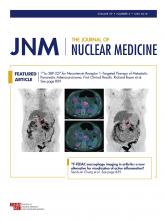See the associated article on page 789.
The well-recognized limitations of conventional imaging with CT, MRI, and 99mTc-methylene diphosphonate bone scans have contributed to a revolution in PET imaging of prostate cancer (PCa). A plethora of PET radiotracers has entered preclinical and early clinical development, and in fact, 2 compounds have been approved by the U.S. Food and Drug Administration for PCa imaging (11C-choline (1) and anti-1-amino-3-18F-fluorocyclobutane-1-carboxylic acid [18F-fluciclovine] (2)). Furthermore, at least 2 different radiotracers targeting prostate-specific membrane antigen (PSMA) are likely to undergo the New Drug Application process at the Food and Drug Administration within the next few years (68Ga-PSMA-11 (3) and 18F-DCFPyL (4)).
However, as these multiple radiotracers become more widely available, it will become necessary for clinicians who treat men with PCa to choose among these agents in an informed manner. That is not a trivial matter, as different radiotracers may have advantages or disadvantages that affect their utility in different clinical scenarios (5), and all radiotracers have pitfalls to interpretation that may be more salient in some patients than in others (6). Understanding these nuances and being able to recommend the appropriate radiotracer in different circumstances will undoubtedly be important foundational knowledge for nuclear imaging specialists.
This precept underlies the importance of the article by Calais et al. that appears in this issue of The Journal of Nuclear Medicine: “Comparison of 68Ga-PSMA-11 and 18F-Fluciclovine PET/CT in a Case Series of 10 Patients with Prostate Cancer Recurrence” (7). In this study, the authors retrospectively reviewed the records of 288 patients with recurrent PCa who participated in a prospective study examining the use of 68Ga-PSMA-11 PET/CT for disease localization. Ten patients were identified who had also undergone imaging with 18F-fluciclovine PET/CT, at a median of 2.3 mo before study enrollment. The median serum prostate-specific antigen level of these patients was quite low (1.0 ng/mL at the time of 18F-fluciclovine imaging and 1.1 ng/mL at the time of 68Ga-PSMA-11 imaging), thus testing the limits of sensitivity for these 2 radiotracers.
The authors observed starkly different detection efficiencies with the 2 radiotracers. More specifically, 18F-fluciclovine was able to identify putative sites of disease in 2 of 10 patients (20%), whereas 68Ga-PSMA-11–avid foci were seen in 7 of 10 patients (70%). Of the 8 patients with negative 18F-fluciclovine results, 5 (63%) had suggestive findings with 68Ga-PSMA-11 PET/CT. In both of the patients with positive 18F-fluciclovine PET/CT results, additional sites of suspected disease were seen with 68Ga-PSMA-11. As noted by the authors, the markedly higher sensitivity of the PSMA-targeted agent led to changes in clinical decision making.
Calais et al. acknowledge that the inherent shortcomings of their small retrospective study limit the conclusions that can be drawn regarding the performance of these 2 radiotracers. The authors’ findings, however, are in keeping with the available literature, which would have predicted higher sensitivity for PSMA-targeted agents at low prostate-specific antigen levels (8–10). Indeed, prospective trials are needed in which patients are imaged with both 18F-fluciclovine and a PSMA-targeted radiotracer within a short interval (1–7 d). Additionally, these studies should aim to compare these radiotracers across a range of clinical contexts (11,12), including the staging of men presenting with newly diagnosed PCa who are at risk for harboring occult metastatic disease, as well as in the setting of castration resistance among patients being considered for endoradiotherapy with PSMA-targeted therapeutic agents (13,14). This latter clinical context is of particular importance because PSMA expression is known to decrease with neuroendocrine differentiation (15,16), and therefore imaging with 18F-fluciclovine or other agents in combination with a PSMA-targeted compound may help identify patients who are poor candidates for endoradiotherapy.
The article by Calais et al. is an important step forward in comparing 2 of the most widely studied PCa radiotracers. It is incumbent on the field of molecular imaging to ensure that additional comparative studies are undertaken to firmly establish the roles of different PCa radiotracers in various clinical settings. Only then can we select the right tool for the job. Without these data, we have nothing more than an embarrassment of riches/radiotracers.
DISCLOSURE
Martin G. Pomper is a coinventor on a U.S. patent covering 18F-DCFPyL and as such is entitled to a portion of any licensing fees and royalties generated by this technology. This arrangement has been reviewed and approved by the Johns Hopkins University in accordance with its conflict-of-interest policies. Michael A. Gorin has served as a consultant to Progenics Pharmaceuticals, the licensee of 18F-DCFPyL. Michael A. Gorin, Martin G. Pomper, and Steven P. Rowe have received research support from Progenics Pharmaceuticals. No other potential conflict of interest relevant to this article was reported.
Footnotes
Guest Editor: Michael Graham, University of Iowa
Published online Jan. 25, 2018.
- © 2018 by the Society of Nuclear Medicine and Molecular Imaging.
REFERENCES
- Received for publication December 26, 2017.
- Accepted for publication December 30, 2017.







